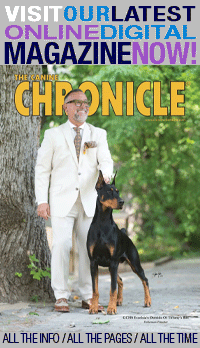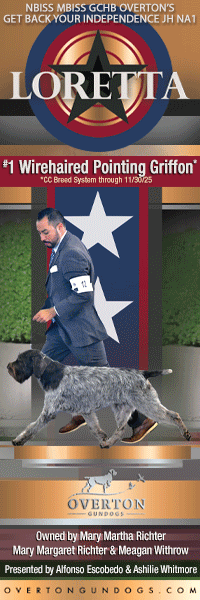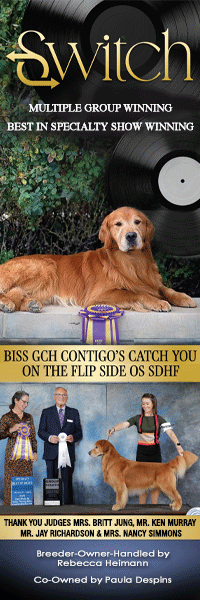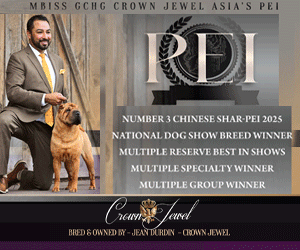Movement Musings
By Juli Lacey-Black
In the development of domesticated dogs, we as humans have created a diverse set of animals to fill almost any need. We have dogs that hunt for a wide variety of game over a wide variety of terrain, dogs that guard us, our stock and our property, dogs that herd our livestock and dogs that fulfill our companion needs in pretty much any situation. A lot of time, effort and thought has gone into the development of each individual breed to produce an animal to fit the human need. In times past it was a very important job for these amazing animals to hunt for us, providing food for our tables and to guard our homes, property and stock so that we could survive a harsh world. However, today we use these great animals less for what they were originally developed for and more as either companions or in some cases show dogs. The question is, at what cost?
In the conformation show ring you see more and more breeds loosing their quintessential breed type that shouts to all “Here I am! I am (which ever breed)!” It is upsetting to me as a breeder of many decades to see dogs in the ring that seem to question just exactly what breed they are. Have we as breeders, given up the very essence that makes our breed – our breed, in order to win the “big ribbon” or to stay high in the over all rankings? Often you can ask someone how they did on any given day and they say “We just won the breed, nothing in the group”, as if that was a disappointment and unfortunately even for me, it is. I like so many others, need to stop and remember that I am a breeder first. A keeper of my breed standard is a job that I have taken on to protect what makes my breed what it is. My job is not to win and rank my dog. This is a hard thing to remember sometimes in the heat of the competition.
So, how do you keep that very important fact in the forefront of your mind? It starts with knowing your own breed standard. When was the last time you read it? You can’t expect every judge to know every idiosyncrasy of your breed. It is up to you as a breeder to put only the best representative of your breed in the ring. I was at a show recently where the exhibitors outside the ring were actually upset that a judge wanted to read their breed standard before judging their breed. Would they rather that the judge went in and just judged looking for a generic dog? A dog that looks and moves as a “dog” and not necessarily the breed they are exhibiting? Not all dogs should be built the same way nor should they move the same way. As I said earlier in this article, each breed of dog was developed over a long time to do a specific purpose. Yet when we judge these dogs we are impressed by huge side-gait and dogs that stop with all four feet facing perfectly forward. We look for a level topline, lots of neck ….basically an impressive dog. But what if the breed in question shouldn’t have any or all of those things? Do you know how your dog should look and move to meet its own breed standard? Not your opinion or interpretation of your standard or what you remember it being or even what has been winning big. The actual requirements of the standard. If you don’t know this, how can you possibly expect a judge who is judging numerous breeds on any given day to know this?
I remember Annie Rogers Clark once saying to me that if you want a dog that can move…go to the pound, most of them can move. But if you want a good typey representative of your breed…go to a breeder. These were wise words from a very wise woman. Yet, most of our dogs have roots in a working animal of some sort – be it hunting, herding or guarding, should they not also be sound and able to move? For me the answer is an unequivocal yes!
So we are left wanting a typey animal that leaves you in no doubt of what breed it actually is and also wanting a sound dog that moves correctly for it’s breed. That’s right…not all dogs should move the same. The AKC standard for the Petit Basset Griffon Vendeen states “Front action is straight and reaching well forward. Going away, the hind legs are parallel and have great drive. Convergence of the front and rear legs towards his center of gravity is proportional to the speed of his movement. Gives the appearance of an active hound, capable of a full day’s hunting.” The AKC standard for the Border Collie stats “When viewed from the side the trot is not long striding, yet covers the ground with minimum effort, exhibiting facility of movement rather than a hard driving action.” The AKC standard for the German Shepherd Dog states “At a trot the dog covers still more ground with even longer stride, and moves powerfully but easily, with coordination and balance so that the gait appears to be the steady motion of a well-lubricated machine. The feet travel close to the ground on both forward reach and backward push. In order to achieve ideal movement of this kind, there must be good muscular development and ligamentation. The hindquarters deliver, through the back, a powerful forward thrust which slightly lifts the whole animal and drives the body forward. Reaching far under, and passing the imprint left by the front foot, the hind foot takes hold of the ground; then hock, stifle and upper thigh come into play and sweep back, the stroke of the hind leg finishing with the foot still close to the ground in a smooth follow-through. The overreach of the hindquarter usually necessitates one hind foot passing outside and the other hind foot passing inside the track of the forefeet, and such action is not faulty unless the locomotion is crabwise with the dogs body sideways out of the normal straight line.”

Incorrect movement - showing over reaching with the rear foot along with moving from the elbow and landing on the back of the front foot.
Did you notice that the standard for the German Shepherd Dog is the only one that states that the dog should actually over reach behind with its rear foot passing the front foot on each foot fall? Yet, how often do we see dogs that are not German Shepherds in the ring and in advertisements that clearly show that “wow” side gait that has tremendous reach and drive, with the rear foot passing the foot fall of the front foot? This for any dog other than the German Shepherd is incorrect movement. Sure it is flashy…. but it is not correct for the breed. Gee…. I guess there is type in movement after all isn’t there? A correctly built dog will be able to move without over reaching behind and will at times have all four feet off the ground. An incorrectly built dog will have a foot on the ground for balance. Included are photos of dogs that move correctly for their breed and incorrectly for their breed.

Correct movement - showing the front and rear foot use the same spot to land without passing each other. The dog is also reaching forward from the shoulder to land correctly on the front foot.
To continue on soundness – how many times do you see dogs in the ring that reach from the elbow and not the shoulder? You may ask why does it matter? If you are looking for a sound dog that can do its job all day, you better believe it matters. A dog that is moving from the elbow is more likely to tire or break down physically and not be able to work a full day like a dog that is built more soundly.
Dogs that move from the elbow tend to do so because their front assembly is not structurally correct or sound. Often dogs with a short second arm or steeply angled shoulder assembly will move from the elbow. At other times a dog will move from the elbow when the length of back to length of rib is off. A dog with more rear angle than front angle will also move from the elbow. You will see the bottom of the front feet coming up and facing up so that their foot fall is actually on the back of their foot and not digging in with the front of their foot for traction. Often a dog that reaches forward from its elbow will also come towards you wide in front perhaps loosely in the elbows and often paddling in front. These are all signs of a front that is for most breeds incorrect. Another wise person once told me that if you truly want to see the front action of a dog moving…send it away from you at a trot. It is amazing how you can tell unsound movement on most breeds (sans bulldog type breeds that are built differently). You will see elbows flying, feet paddling etc. Below are some photos that clearly show the difference in moving soundly from the shoulder and unsoundly from the elbow.

Incorrect movement - moving from the elbow consequently lifting the front foot to land on the back of the foot

Correct movement - reaching well forward from the shoulder with no lift of the underside of the foot
Once again, we see where movement does have a lot to do with breed type. The dogs,as I keep saying, were developed to do a job. Their development created a breed type. That breed type is defined in their body structure, head piece, sometimes color and coat but almost always movement. So the next time you see a dog in the ring and someone next to you says “why did that dog win? it can’t move…” think about the breed standard. If it is a Chow-Chow that should have a stilted side gait, kudos for the judge that rewarded that dog over perhaps another dog that moved “bigger” but less correctly. If it is a Petit Basset Griffon Vendeen then shame on the judge who forgot for that moment that a PBGV is a dog that should reach well forward and have great drive when moving. If it was a German Shepherd then truly shame on the judge for rewarding a totally incorrect movement. But…. wait… could it be that the person standing next to you doesn’t truly understand soundness and correct movement and does not see that the dog in question actually did move correctly? Perhaps then is the time to educate that person. We are all ambassadors of our breed. We are all keepers of our breed standards. Don’t get annoyed at someone that clearly doesn’t understand about soundness or correct type… educate them!
Short URL: http://caninechronicle.com/?p=36641
Comments are closed












